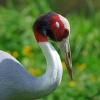Sexes alike. Small ear tufts and upright posture. Greyish-brown above, profusely marked whitish; buffy nuchal collar diagnostic; buffy-white underbody, streaked and mottled dark. The very similar Indian Scops Owl O. bakkamoena is mostly distinguished by its call. Solitary or in pairs; remains motionless during day in thick, leafy branches or at junctions of stems and branches; very difficult to spot; flies around dusk.
- Browse
- Gallery
- Checklists
- Topography
- Glossary
- Bibliography
- Feedback
- About Us









